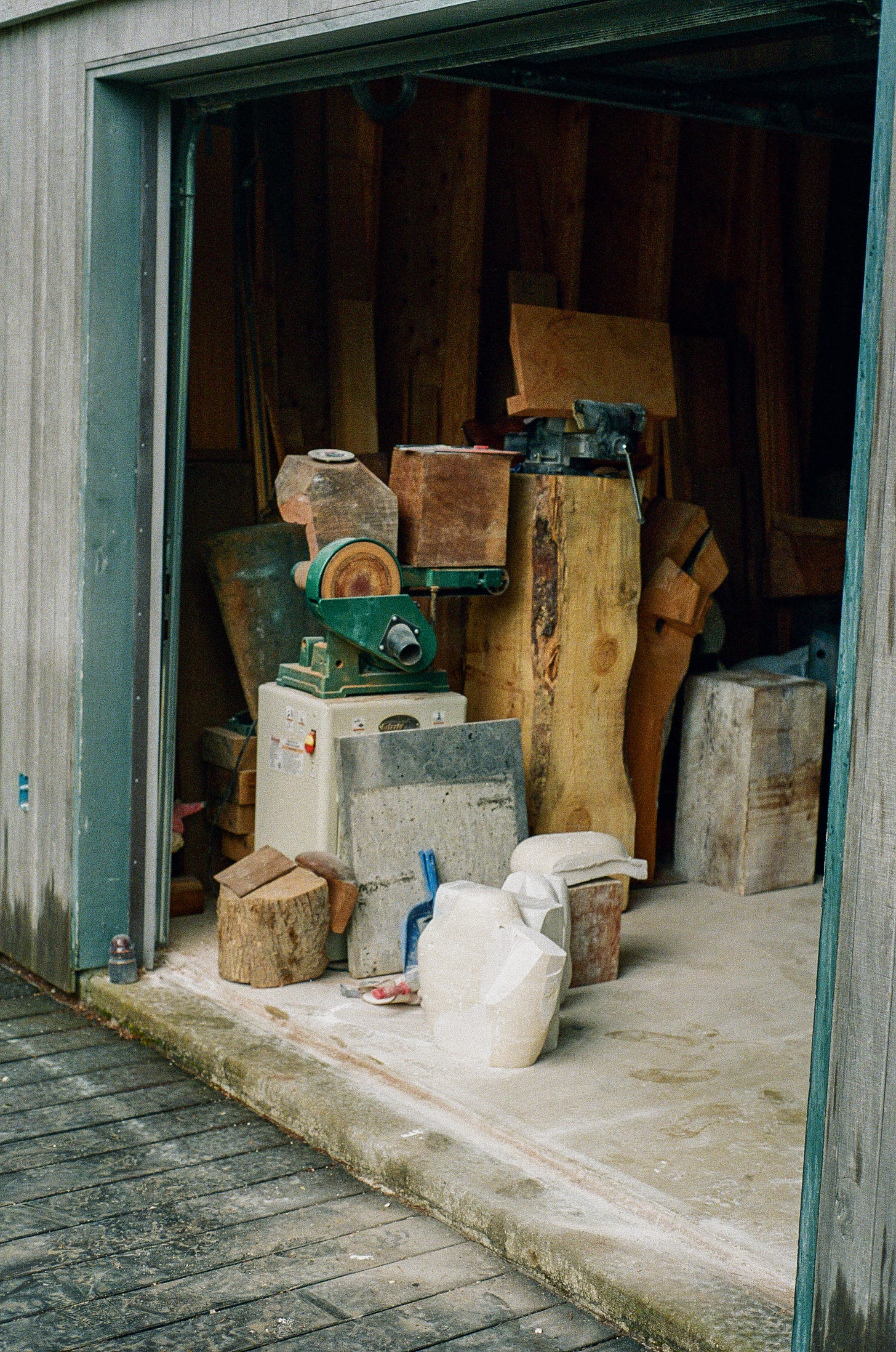Studio visit with Christopher Belluschi
Sculpting stones and stumps into abstract forms, one cut at a time
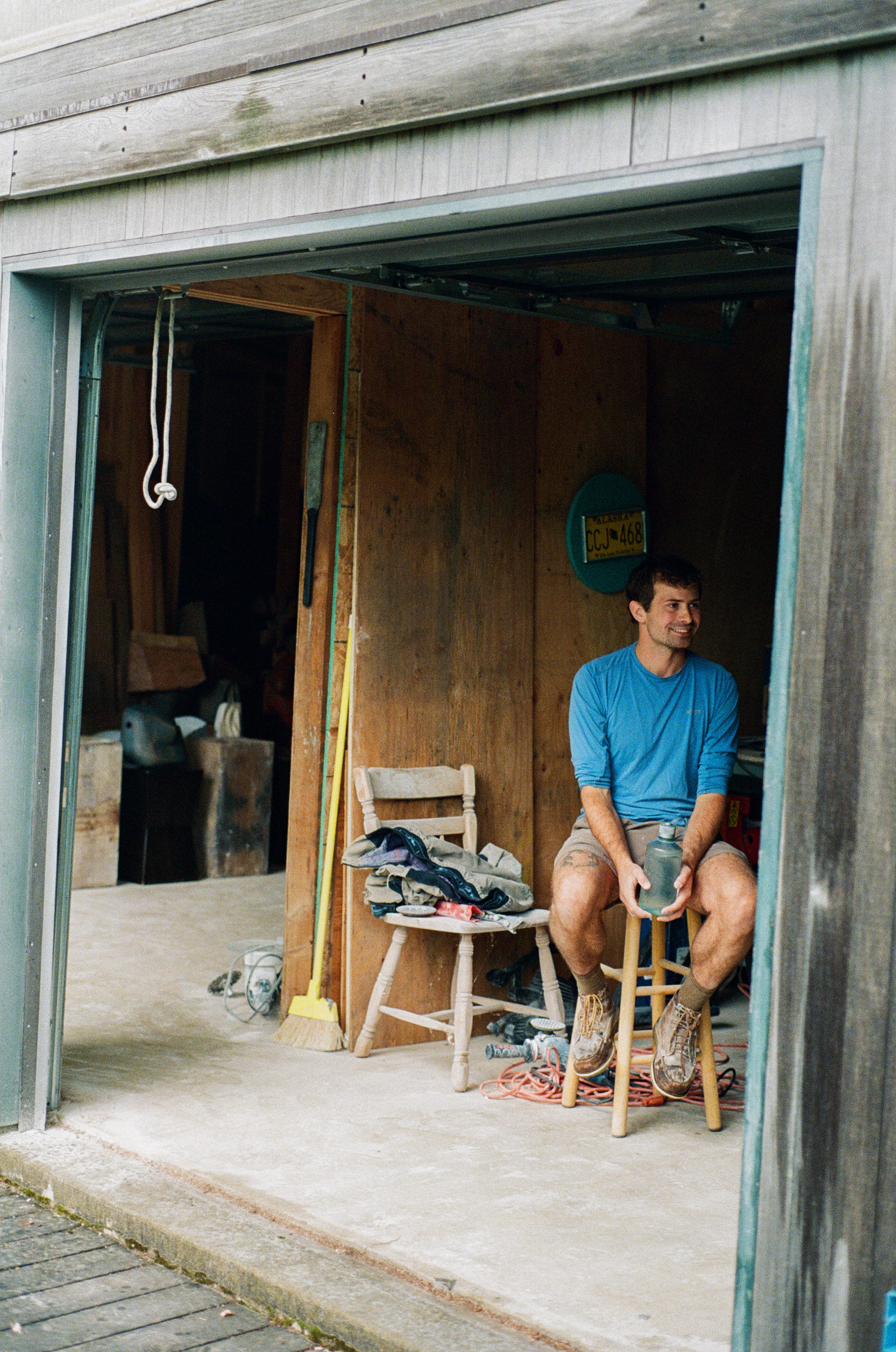
As I approach the driveway to Christopher Belluschi’s studio in the hills west of Forest Park, I see a figure waving through the fog. It’s Chris, wearing a worn-in jacket, shorts, and Danner boots, making sure I don’t miss the turn off Skyline Boulevard. Only once I’m parked can I appreciate our setting: tall, full trees circling the perimeter, the back view of an artists’ home built in 1962, and Chris’s studio, with large open doors overlooking a grassy meadow. It has been his workshop for the past two years, since family friends invited him to work there.
Even if Chris didn’t want to be an artist himself, his identity is inescapably tied to the art world through ancestry. He is the great-grandson of Italian-American architect Pietro Belluschi, a leading figure in modern architecture who designed the 1932 Portland Art Museum and 1,000 other buildings. But having gone to school for printmaking, lived in some of the most beautiful parts of Europe, and forged his own path as a sculptor, Chris is gaining his own recognition and becoming even more intertwined with Oregon’s creative community.
It’s been a monumental year for him: He escaped for six weeks to Carrara, Italy to chisel rocks in the company of his mentor, sculptor M.J. Anderson. While there, he placed an order for four tons of red travertine, yellow travertine, Italian travertine, and black marble, arriving soon. Also of note: One of his pieces was featured in the background of an interview in the new HBO docuseries “Chimp Crazy.” And fittingly, a selection of his work was recently exhibited in the iconic Joss House, designed by his great-grandfather in 1941. Today, you can view some of his sculptures in the Taking Shape: Here and There show alongside painter Pam Greene at the Cannon Beach Art Association’s gallery, up until September 22.
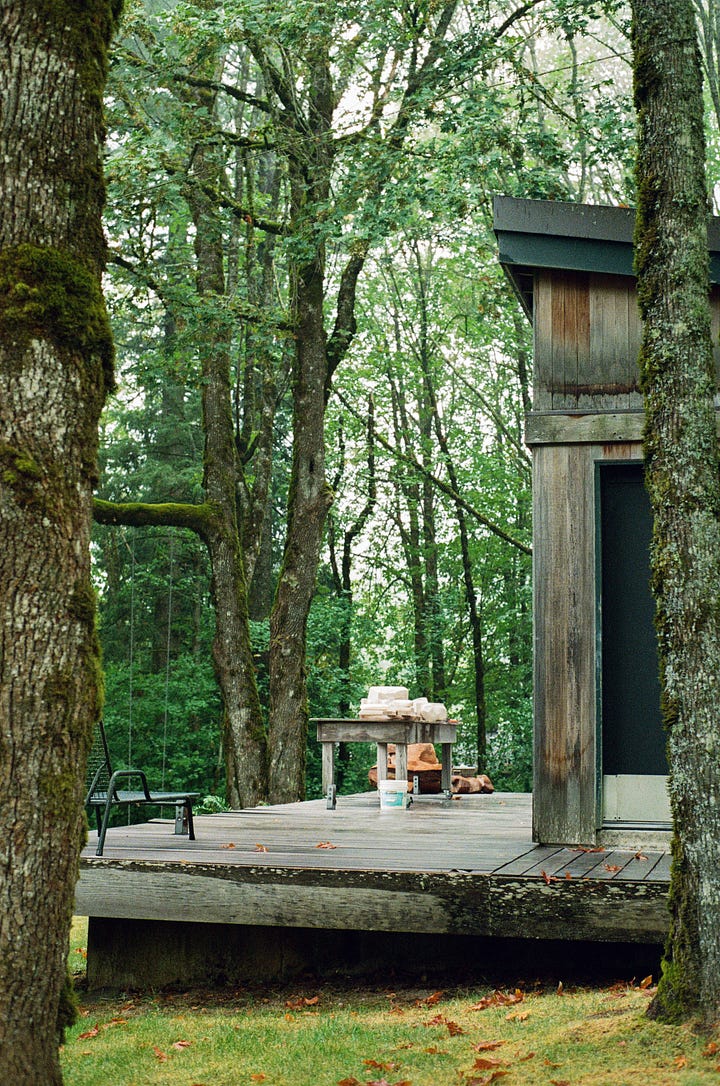
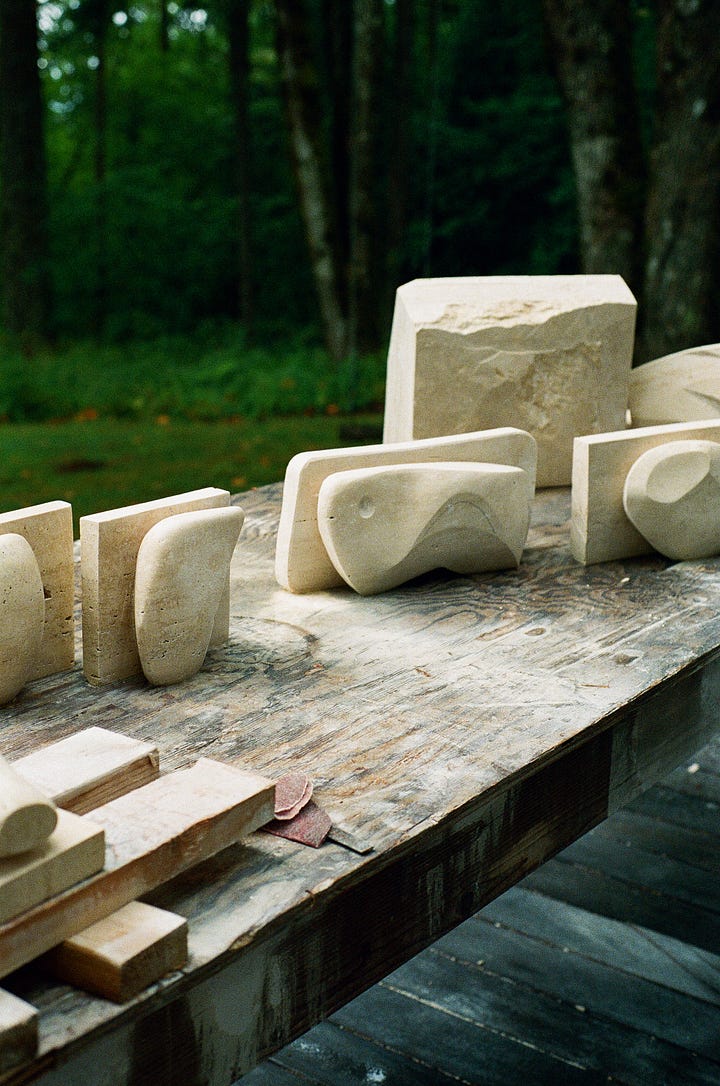
Thanks for sitting down with me, Chris. I want to start with your origin story. Did you choose sculpture or did sculpture choose you?
My conception of nice form and quality material began as a kid picking up rocks, bones, and cool pieces of wood from the beach. At the end of college, I started collecting really big pieces of wood. I’d think about making a sculpture, but I had no idea how to do it. I ended up just sawing or whittling. You can’t really get very far with a pocket knife, but I was a little apprehensive of working with power tools.
After college, I spent a year in Madrid, Spain. I wasn’t making art, but I was surrounded by architecture, design, and fashion. As inspiring as it was, I was ready to get to work. When I returned to Portland, I worked in an electric guitar shop simply because it got me workshop experience. A CNC machine made the guitars, and I was finishing them, sanding them, and glueing them up. It was minimum wage but to get that experience was worthwhile. After that, I worked at The Good Mod doing furniture restoration. I got even more workshop experience and learned more tools while trying to do some sculpture on the side. It took me four months to carve a sculpture with a chisel and hammer. I thought, if I’m ever going to become a sculptor, this is way too slow. I asked my mentor, M.J. Anderson, about power tools and she invited me to come work with her on the coast two years ago. That’s where everything started.
How did you find a mentor in M.J.? And how has your relationship shaped your trajectory as a sculptor?
My grandparents bought one of M.J.’s sculptures 20 years ago so I had heard about her. The first time I ran into her, I got her email address and went to visit. I asked her if she had scraps of leftover marble that I could have or purchase to incorporate into some wood I was whittling. She said no, she didn’t do that. Two or three meetings after that, nine months later, I showed her some stuff I was doing. I said I wanted to get serious about this sculpture stuff. That’s when she invited me to come work with her. It was a shock. She taught at Marylhurst briefly so she’s got a teacher’s heart. It became a mentor-mentee thing very quickly. I think she was surprised that I listened to everything she said. When she said “buy this tool” or “talk to this person” or “sign up for this symposium,” I would do it. She would facetiously tell people, he’s the only person who listens to me. Why would I not? This is an opportunity of a lifetime and she’s showing me the blueprint. I probably wouldn’t be doing this right now if it weren’t for her saying “do this.” I would’ve taken the long route and gone off on some different path.
When you’re turning stone to sculpture, how do you begin?
I grew up drawing a lot. When I started sculpting, I thought I’d be able to draw and conceptualize the sculptures I wanted to make. But that doesn’t happen at all. Once it’s started, I try to sketch shapes because it’s a good exercise. That’s only after it’s been touched. It really often starts with a block. I’ll sit and stare at it, and I’ll ponder. And I’ll play some music, and I’ll ponder. In the winter, I have my heater, so it’s easy to ponder. I ponder what it could be until I can’t take it anymore and need to do something. Then I just take my best educated guess. It’s not like I’m making a mold; there’s no undoing. I usually have an idea of what’s the top, what’s the bottom. Then I look at the material, feel the material, and go from there.
Where do you find yourself pondering when you’re in the world?
I love art history, archeological art, and historical works, and seeing different ways people made things. Things that were dug up and being like, I don’t know how they did that 3,000 years ago. There’s the scale of work, then there’s the detail of work. I’m having a hell of a time getting into the crevices even though we have such modern tools now. Can you imagine what rudimentary tools they had for that back then? If they can do it, I should be able to figure it out.
As far as where I ponder in the real world, the Oregon Coast is one of my favorite places. Where I go in Neahkahnie and Manzanita, big, basalt boulders came down the cliffs as chunky, sharp blocks. Now they’re these luscious forms rounded by the elements that I really like. I get inspired when I least expect it, when I’m keeping my eyes open all the time.
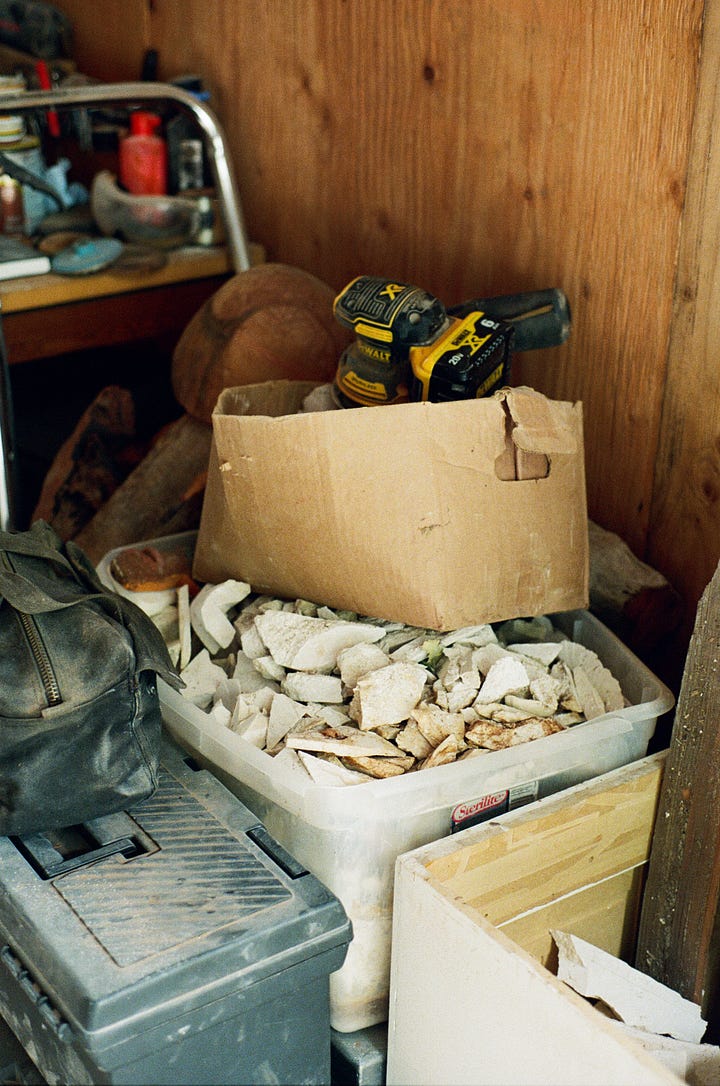

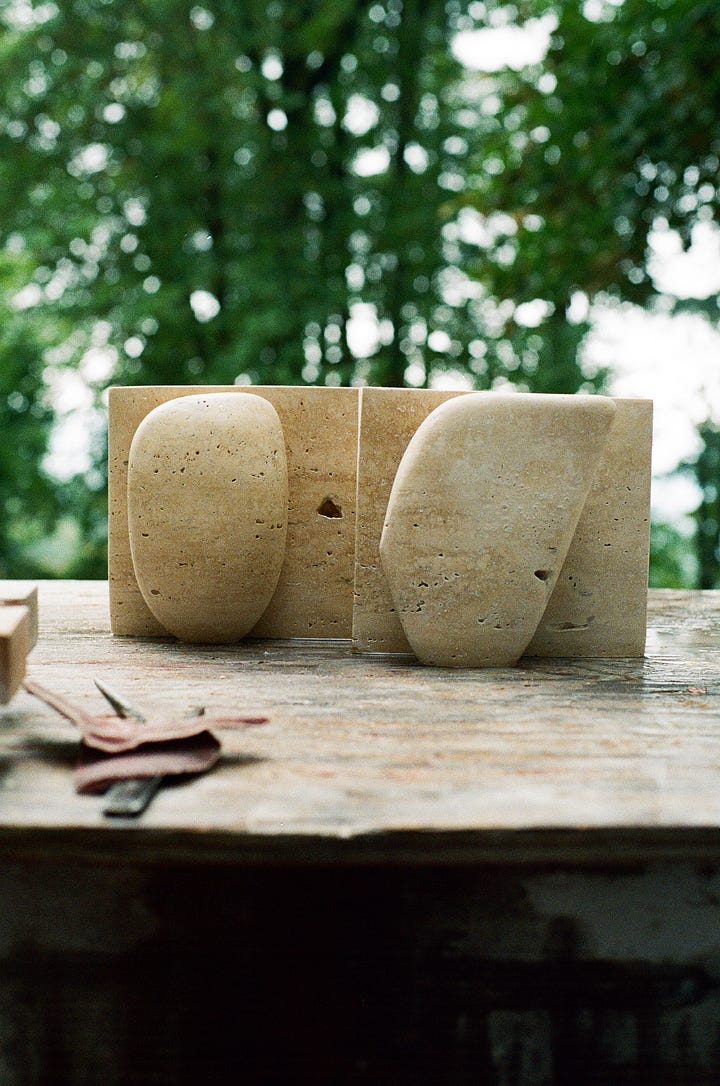

On the walls of your studio: “A butterfly ID poster from my grandfather; a Smokey Bear poster; a photograph of my great-grandfather Pietro and the sculptor Henry Moore; a photograph my dad gave me of my great-grandfather with Leroy Setziol, an Oregon artist and a print I made when I was studying abroad in Italy.”
What you do to relax that isn’t art: “Basketball. I’ve played pickup at parks this summer.”
Tool you don’t have but want: “I did say I don’t want to get involved with a Diamond-studded chain saw, but some of the stone I have is so big I’ve created logistical problems that I don’t have answers for currently.”
Food indulgence: “My fiance’s eggplant parmesan.”
Simple pleasures lately: “My air conditioning unit. We didn’t have one for a little bit and it gets so hot. Old house.”
Currently reading: “I’m reading a book on Louise Nevelson. She’s an artist in the ‘30s to ‘80s. M.J. was reading this book and gave it to me, so I’m making my way through it.”
First piece you sold to stranger: “A rather large, abstract piece made of black Nero Marquina marble. Through a series of connections I ended up driving it all the way out to its home in Traverse City, Michigan.”
It’s so apparent that this space is supportive of and conducive to your work. What about your studio do you love?
It’s an impermanent situation, but it by all means is the ideal situation—besides me not living here. I’d love to walk out with my morning coffee, but I have a half-hour one-way commute. I’m not complaining. This space is a dream as far as being able to commune with nature every day, and watch the seasons and weather roll by. Flowers blossom. Leaves fall. Snow comes. I always want to be able to work outside. And I need solitude to get my work done. I think I’m a little too self conscious to work in a space with others. This space is the blueprint for what I would like to have of my own in the future, wherever that might be.
Inevitably, you end up with a piece you don’t like and have to rework it. It sounds necessary, but is it an emotional process?
No, I don’t think it is. I had a couple pieces that were sitting here all winter long. It’s been a little hectic this summer since I got back from Italy. It feels like just a daydream because I acquired all this stone and I started all these projects there, then I returned home and I was back where I was in March with my same materials and tools. I felt like, did any of that happen? I came back to these reliefs and hated them. Hate is a strong word, but I really wasn’t fond of them. There was a lot of good material in there. It wasn’t that hard of a decision to begin the salvage operation.
Since committing to your practice, how has your art evolved?
When I started, I was pulling wood off the beach. It was all gangly and funky, and I would try to maintain as much of the form as I could. I would end up with these crazy sculptures. Back then, I was focused on the theoretical study of art—like the white cube (gallery space) and how to talk about art and the whole mystique. I think if you’re creating work for the white cube, you don’t really care how it fits into the environment because it’s against a blank slate. It’s very individualistic. What I’ve come around to in the last year or two is thinking about what I want to frame my work with. I think it gets humbled when you have to incorporate it into a considerately designed space. You see how it exists in space and the gravity it has. A lot of the early work I’ve made, no one is going to want this in their house. I’m trying to sell work, I’m trying to make things people can enjoy. If that’s the frame of reference, does it fit? Does it work? That’s where I’m at now.
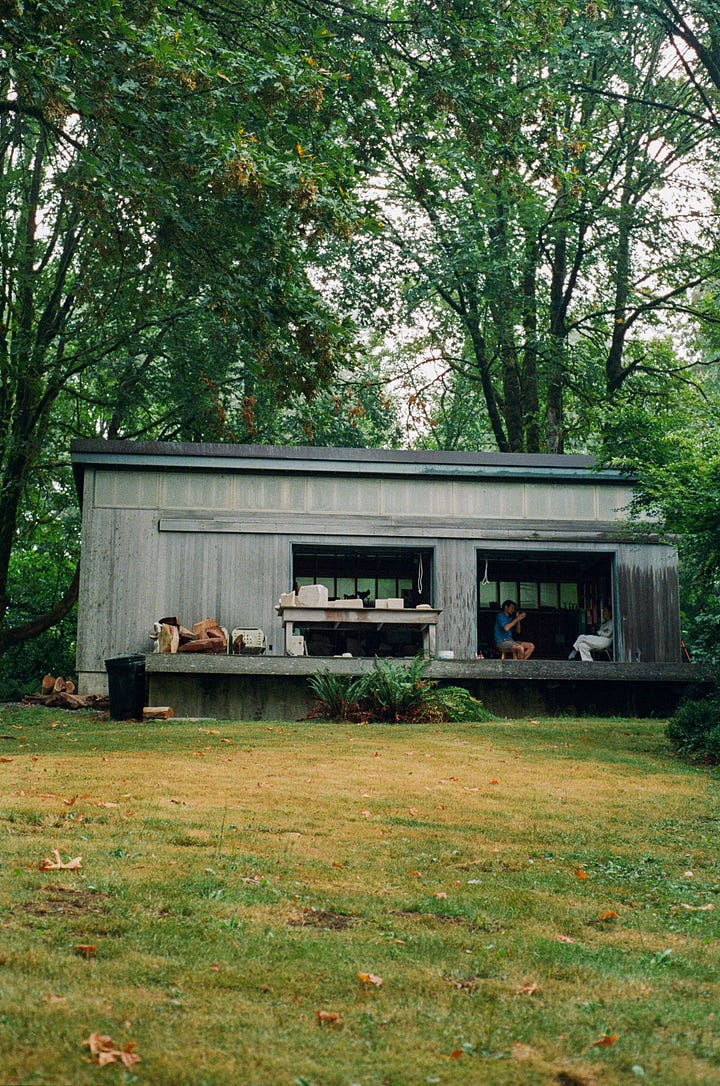

Amelia Arvesen (she/her) is the creator of Honing Her Craft and a freelance journalist who integrates her artistic side into her every day. The STUDIO VISITS series merges her curiosity as an interviewer with her admiration of creative practices and people.
Lauren Beane (she/her) is a freelance photographer specializing in film. She values a life centered around art, nature, community, and little pleasures. This series allows her to expand her definition of what it means to live a creative, artful life while providing others a window to do the same.
You can find previous editions of STUDIO VISITS here. Support this series by liking it, forwarding it, or upgrading to a paid subscription.




